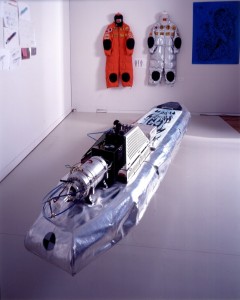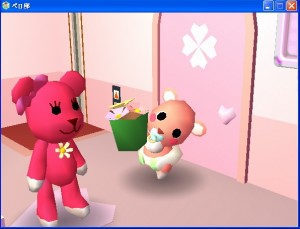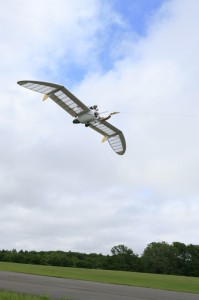Soft light from the high ceiling at prestigious Spiral Hall in Aoyama, Tokyo, reflects on the white wings of a seagull-shaped M-02J jet glider.The Open Sky exhibition in December 2008 shows the latest development of the ‘personal’ project of artist Kazuhiko Hachiya. Launched in 2003 to build a functional aircraft for personal use, the glider resembles “Maeve”, the aircraft used by the heroine of Hayao Miyazaki’s 1984 animation film Nausicaä of the Valley of the Wind. Although the original plan was to have a girl as a pilot, staying true to the film, eventually Hachiya decided to test-pilot the aircraft himself because of the possible risk. Early stages of the development included numerous test flights without the engine to examine its gliding capability, however a jet engine will be installed on the final model.
Using a jet engine itself is not new to Hachiya. AirBoard (Collection in the Museum of Contemporary Art Tokyo, 1997-2001) was a realisation of the flying skateboard in the 1985 Hollywood blockbuster Back to the Future. The artist purchased the “world’s smallest jet engine” at the time and was trained to handle the volatile engine.
Not all of Hachiya’s projects involve bodily risks. He has been known for interactive works such as Inter Dis-Communication Machine (1993) that literally exchanges the sight and sound of two participants by using two wirelessly connected head-mounted displays. The resulting experience is just hilarious. With Seeing is Believing (1996) and the recent Fairly Finder series, LCD and polarized films are cleverly combined to make the invisible visible. He has also turned the façade of the ten-story Chanel building in Ginza into a huge animation screen since it opened in 2004. 700,000 white LEDs installed behind the glass surface glitter to show sequences created by young artists he invites every month. His project PostPet has been a popular email software program among teenage girls since 1998 with a variety of virtual pets that “live” on PC or cell phone screens. Maintained and updated by his own company PetWorks, in collaboration with Sony Communication Networks, the pink teddy bear Momo has become a well-known virtual character in Japan. Actually it was the success of PostPet that enabled Hachiya to finance projects such as AirBoard and Open Sky. Collaborating with the industry is sometimes needed for his projects. ThanksTail is a car accessory which was commercialized by a subsidiary of Takara, a major toy manufacturer.
Once attached to the rear end of the car’s roof, the “doggy-tail” could be remotely wagged to thank or apologize to other drivers. In Hachiya’s own words: “Drivers can have more friendly communication.”
Playfulness and serious concepts are inseparable in Hachiya’s art, but why would an artist create an aircraft? “Dreams may come true if you try seriously,” says Hachiya, “and an artist can show it. Everyone dreams of flying freely as a child.” The artworks lead to a social and political context and in reality, ‘flying freely’ is not realised because of politics and business. He hopes to “open” the sky to individuals, not only by flying himself but also by using open-source software, publishing his design/development process, uploading document videos on YouTube, and making the project an arena for collaboration and discussion.
Playfulness, entertaining inventions, commercially-available products — these features often seen in media art today reflect a long Japanese cultural tradition. Nintendo, for example, was founded 120 years ago as a publisher of playing cards including Hyakunin Isshu, a poem card game enjoyed among the people for centuries. In Japan, art has long been a part of everyday life, and new technology has been always used for entertainment, as with tea-carrying automata used at teahouses in 19th century.
Artists such as Hachiya have been focusing on establishing a new approach in art by exploring the boundaries between art, design, entertainment and technology. Recently, he and a group of artists, engineers and researchers have launched a concept named Device Art, promoting hardware-based art in the form of devices or gadgets like Hachiya’s products. The Device Art project already has a permanent exhibition space at Miraikan (National Museum of Emerging Science and Technology, Japan), where Hachiya exhibits now. Like Hachiya, the Device Art concept strives to push the borders of art and bring it outside museums and galleries.
Machiko Kusahara
Machiko Kusahara, Ph. D. is a media art curator and scholar in media studies. Since the early 1980’s she has written, curated exhibitions and served as a jury member for international competitions in computer graphics and media art. Her research is on the interaction between art, technology and society, as well as on early visual media such as magic lanterns and panoramas in 19th century Japan. Currently she is a professor of Media Art and Media Studies at Waseda University, Tokyo.
Watch More
 This work is licensed under a Creative Commons Attribution-NonCommercial-ShareAlike 2.5 Australia.
This work is licensed under a Creative Commons Attribution-NonCommercial-ShareAlike 2.5 Australia.










[...] Sky Is My Screen in Filter Issue 70, Screen [...]